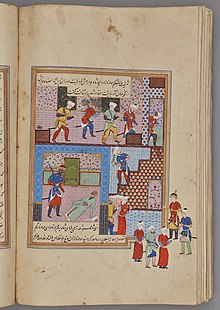| This article includes a list of general references, but it lacks sufficient corresponding inline citations. Please help to improve this article by introducing more precise citations. (March 2018) (Learn how and when to remove this message) |

Mubariz al-Din Muhammad (Persian: مبارز الدین محمد; 1301–1363), was the founder of the Muzaffarid dynasty, ruling from 1314 to 1358. He was born to a family of Persians with distant Arab origin, which settled in Khurasan during the Islamic conquest. He was the son of Sharaf al-Din Muzaffar, a servant of the Ilkhanids and on his father's death in 1314 Mubariz inherited his father's offices.
Mubariz al-Din lived at the court of Ilkhanid ruler Öljaitü until the latter's death. After Öljaitü's death, Mubariz al-Din left for Maibud, and in 1319, he captured Yazd from Hajji Shah ibn Yusuf Shah, the Atabeg of Yazd, thus putting an end to the Atabeg rule over Yazd. Sometime later, the people of Sistan rebelled against the Ilkhanids, and Mubariz al-Din was ordered to subdue the province, which he did. However, the people of Sistan shortly rebelled, and Mubariz al-Din was once again to forced to fight them; he reportedly fought the rebels in 21 battles until the province was finally subdued.
In the wake of the loss of Ilkhanate authority in central Iran following the death of Abu Sa'id, Mubariz al-Din continued to carry out his expansionary policy, and declared independence from the Ilkhanids. In 1339 or 1340 he invaded the province of Kirman and seized it from its Mongol governor, Kutb al-Din ibn Nasir. Kutb al-Din was able to retake the province for a short time after receiving aid from the Kartid dynasty of Herat, but Mubariz al-Din permanently gained control of Kirman in late 1340. The city of Bam was besieged and conquered a few years after this.
After the conquest of Kirman, Mubariz al-Din became a rival of the neighboring Injuids, who controlled Shiraz and Isfahan. Although the Muzaffarids and Injuids had traditionally been on friendly terms with one another, the Injuid Abu Ishaq Inju's desire to gain Kirman led him to start a drawn-out conflict with the Muzaffarids in 1347. He unsuccessfully besieged Yazd (1350–1351), after which his fortunes declined rapidly. During the same year, he sent an army to Kirman, which was defeated by Mubariz al-Din.
In 1353, Mubariz al-Din captured Shiraz from Abu Esshaq. Abu Esshaq, however, managed to escape from Shiraz and fled to Isfahan, but Mubariz al-Din pursued him, took the city and executed the Injuid ruler. Fars and western Iran were now under his control.
With the destruction of Injured authority, the Muzaffarids were the strongest power in central Iran, and Shiraz was made their capital. Mubariz al-Din's strength was such that when the Khan of the Golden Horde, Jani Beg, sent an offer to become his vassal, he was able to decline. In fact, he pushed on into Azerbaijan, which Jani Beg had conquered in 1357. He defeated the khan's governor Akhichuq and occupied Tabriz, but realized that he could not hold his position against the Jalayirid troops marching from Baghdad and soon retreated. The Jalayirids would therefore maintain a hold on Tabriz, despite further attempts by the Mozaffarids to take it.
Mubariz al-Din was known as a cruel ruler, and soon afterwards in 1358, his son Shah Shuja blinded and imprisoned him. A temporary reconciliation was reached, but it failed to last and he died, again in prison, in 1363.
Sources
- M. Ismail Marcinkowski, Persian Historiography and Geography: Bertold Spuler on Major Works Produced in Iran, the Caucasus, Central Asia, India and Early Ottoman Turkey, with a foreword by Professor Clifford Edmund Bosworth, member of the British Academy, Singapore: Pustaka Nasional, 2003, ISBN 9971-77-488-7.
- Patrick Wing (11 November 2014). "Mozaffarids". Encyclopædia Iranica Online edition, 2014. Encyclopædia Iranica Foundation. Retrieved 2025-01-21.
References
- H. R. Roemer (2006). "The Jalayirids, Muzaffarids and Sarbadars". In Jackson, Peter; Lockhart, Lawrence (eds.). The Cambridge History of Iran VI -The Timurid and Safavid Periods. Cambridge University Press. p. 11. ISBN 9780521200943.
- René Grousset (1970). The Empire of the Steppes: A History of Central Asia. Rutgers University Press. pp. 390. ISBN 978-0-8135-1304-1.
- Peter Jackson (1993). "Muzaffarids". In Clifford Edmund Bosworth; et al. (eds.). Encyclopaedia of Islam. Vol. 7 Mif-Naz (New ed.). E J Brill. p. 820. ISBN 9789004094192.
| Preceded bySharaf al-Din Muzaffar | Muzaffarid ruler 1314–1358 |
Succeeded byShah Shuja |
| Rulers of the Muzaffarid dynasty (1314–1393) | |
|---|---|
|